Managing Financial Principles and Techniques : Report
Added on 2020-01-07
34 Pages9679 Words134 Views
MANAGING FINANCIALPRINCIPLES AND TECHNIQUES1

TABLE OF CONTENTSINTRODUCTION ...............................................................................................................................3TASK 2.................................................................................................................................................3TASK 3.................................................................................................................................................73.1 Selecting appropriate budgeting target......................................................................................73.2 Create/generate a master budget of Boris Badenov...................................................................93.3 Compare actual expenditures and incomes to the master budget of Boris Badenov...............113.4 Evaluate budgetary monitoring processes of Boris Badenov..................................................13TASK 4...............................................................................................................................................144.1 Recommending ways that helps in managing cost reduction in an organization ...................144.2 Evaluating the potential for the use of activity based costing ................................................16TASK 6 ..............................................................................................................................................176.1 Analyzing the financial statements to assess the financial viability of Sainsbury ..................176.2 Analyzing the financial performance of Sainsbury .................................................................296.3 Recommending actions to Sainsbury for making improvement in the financial performance.......................................................................................................................................................31CONCLUSION .................................................................................................................................32References..........................................................................................................................................342
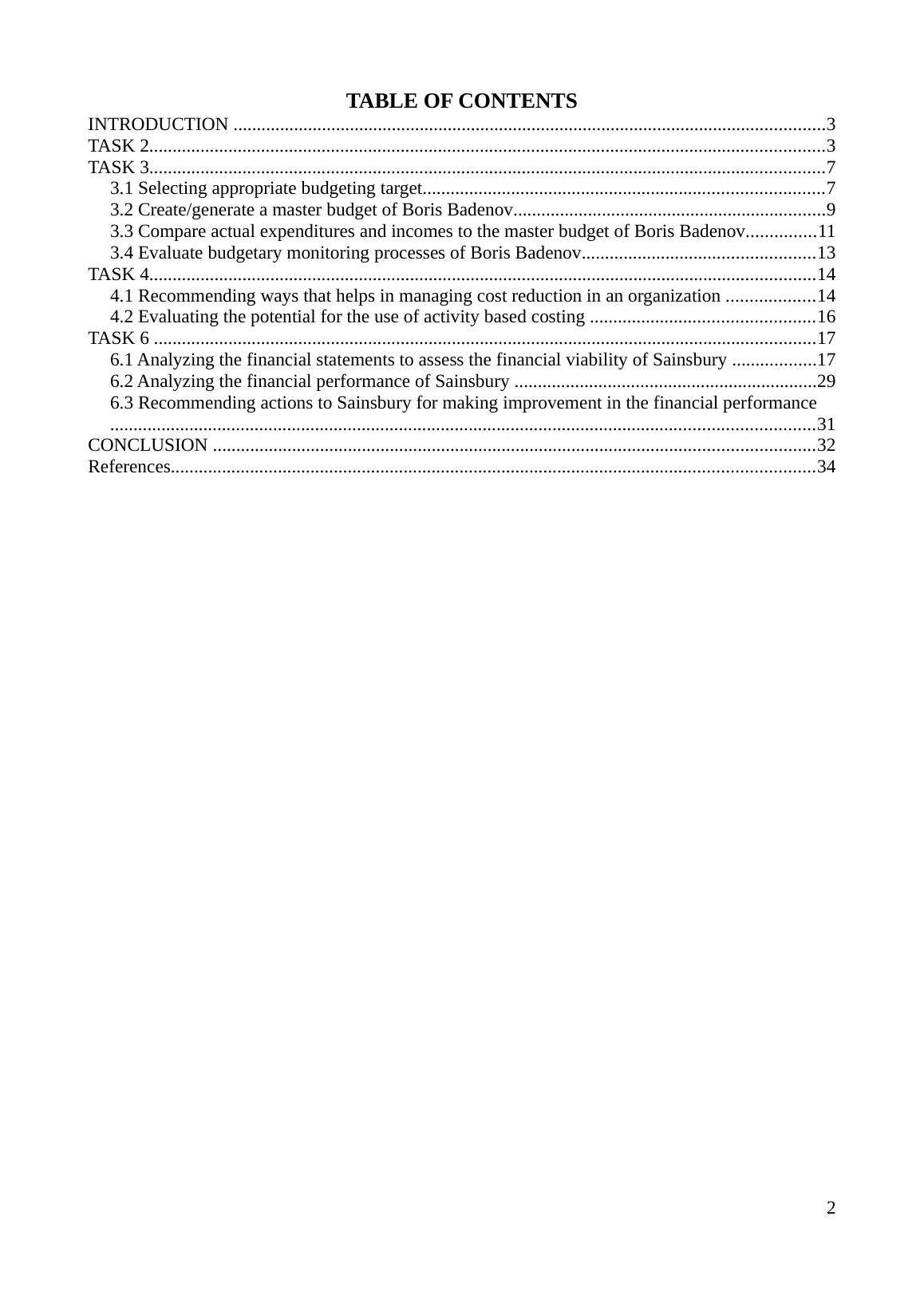
INTRODUCTION Finance is the most crucial element of each and every business organization because in theworld of dynamic and complex environment, none of the enterprises can survive in the marketwithout having appropriate quantity of funds. Finance may be required for short-term, medium-termand longer period depending upon the purpose of use (DRURY, 2013). Short term finance may beneeded for the payment of expenditures like wages and salaries, purchase material, insurance, rent,stationery, printing etc. while long term funds may be required for fixed assets like property, plantand equipment, machinery, business expansion, purchase new technology and introduction of newproducts as well as services. Present project report will address different types of sources that company can use toacquire required quantity of funds. Moreover, the report will explain the importance of forecasting,capital appraisal, budgeting and analysis of financial performance to take good quality of decisions.Furthermore, variance analysis will be done to compare actual performance with the targets in orderto take corrective actions to mitigate adverse variances and thereby, to achieve target goals. Inaddition, various ways will be suggested to reduce business cost and enlarge profitability. Besidesthis, use of activity based costing (ABC) will be explained to compute cost on the basis of costdriver. TASK 2As per the scenario, Boris Badenov is a public listed company which has discovered thepricing trend of its product which is given here as under:Y = 100 + 5XHere, Y = Sales volumeX – Quarterly time periodSeasonal variations of product for recent quarters are as under:3
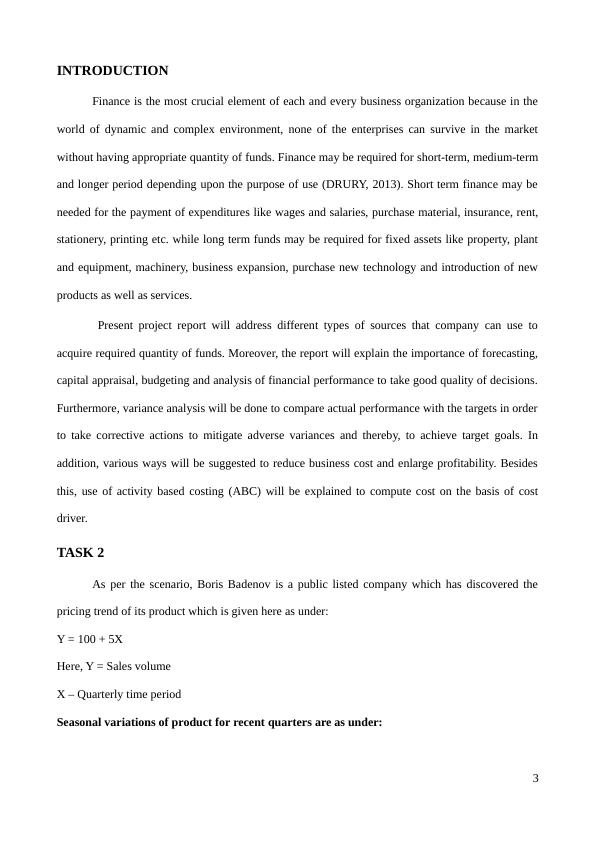
QuarterSeasonal effect Quarter 1NilQuarter 2-20.00%Quarter 340.00%Quarter 4-20.00%Forecasting sales volume, sales price and total sales QuarterSales volume(Y = 100+5X)Sales price Total sales value(Sales volume * saleprice)Quarter 1100 + 5(20) = 200 units 1000200000Quarter 2100 + 5[20-(20*20%)]= 1801000 + (1000*2%) =1020183600Quarter 3100 + 5[16+(16*40%)]= 2121020 + (1020*2%) =1040.4220564.8Quarter 4100 + 5(22.4-(22.4*20%)]= 189.61040.4 + (1040.4*2%)= 1061.21201205.42Advantage of time series:It is an effective quantitative and qualitative technique that provides huge assistance to BorisBadenov's management to accomplish their target objectives by the means of forecasting. Thebenefits of time series analysis are given below:It helps to forecast future trend of given data on the basis of their past behaviour. Thetendency of historical occurrence shows potential increase or decrease in sales for the futureperiod (Cross, n.d.). This prediction provides assistance to make strategic policies and takedecisions to mitigate unfavourable trend. Analysis and comparison of past sales behaviour over a period reveal seasonal effects thathelps to create more realistic estimation for the future (Box and et.al., 2015). Such seasonalpattern is more important for the forecasting of products which demand is fluctuatesseasonally. It provides assistance to Boris to measure both financial as well as endogenous growth in the4
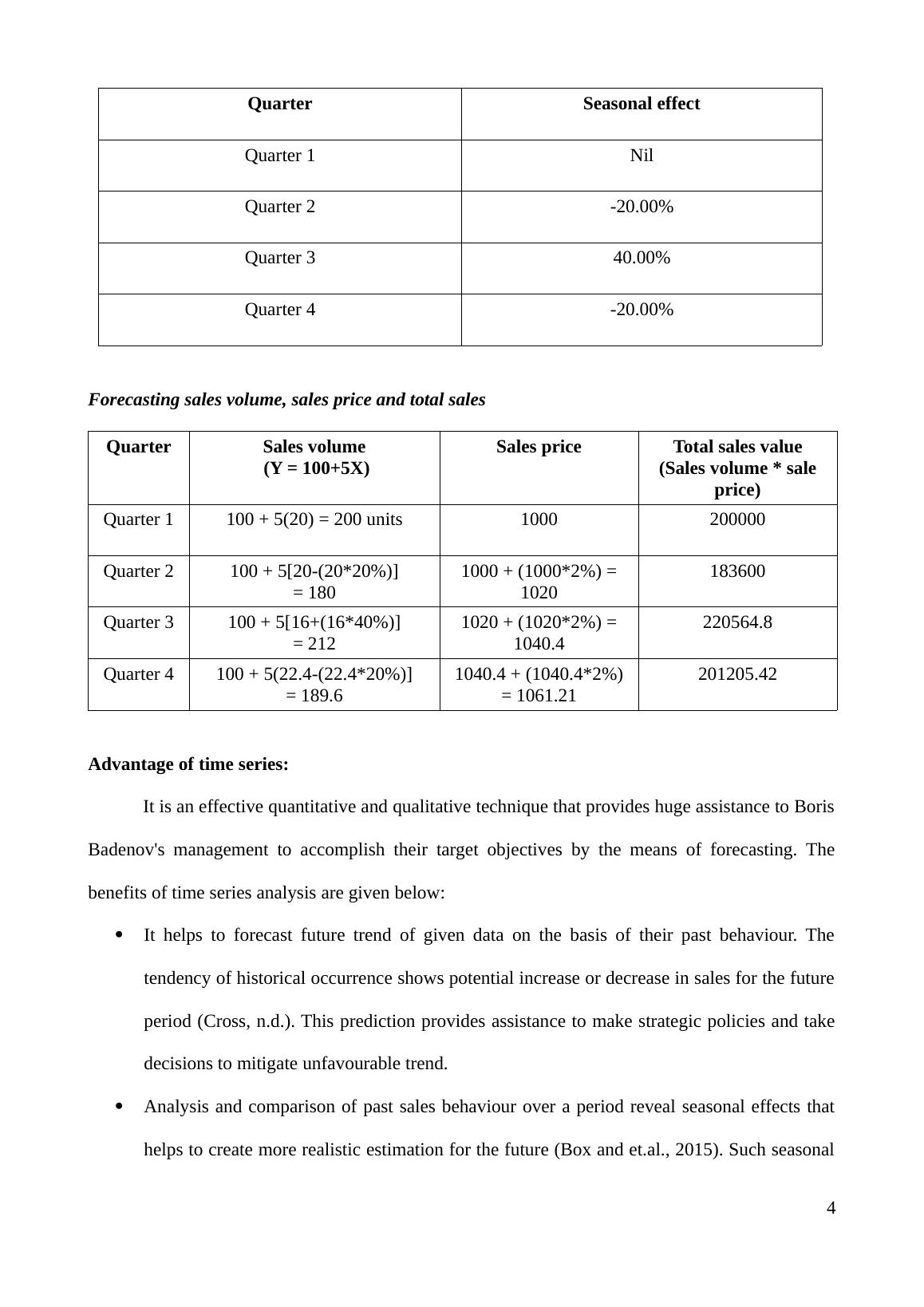
future period. Disadvantage of time series: In the present age of volatile and tougher business environment in which externalenvironment is changing at faster pace, trend analysis may not provide correct estimation(Cross, n.d.). Thus, it can be said that in long term period, the trend analysis is not veryuseful tool for forecasting. Historical analysis does not provide correct information regarding what will be happen infuture. It may be increase or decrease depending upon the market volatility (Shumway andStoffer, 2013). 2.2 Assessing the sources of funds available to Boris Badenov for the expansion in Europe and UKThere are number of sources available to Boris Badenov to raise funds for the businessexpansion in the country of Europe and United Kingdom. These sources are given below:Share capitalThe most common source of finance for Boris is to acquire funds by using the form of sharecapital. Boris can issue both the ordinary and preference share capital in the market and sale to thepotential investors so as to obtain funds in required quantity (Tong, 2012). Differences betweenboth the sources are given below:Preference share capital: This type of share has two preference over equity shareholders.One is regarding payment of fixed rate of the dividend and other is regarding repayment ofcapital at the time of liquidation. Preference shareholders are not owners of the company. Ordinary share capital: It is also known as equity share capital and they have no preferencesregarding repayment of capital and payment of dividend (Manning, 2013). Equityshareholders are owners of the company and they can control business operations by usingvoting rights. By issuing both the shares, Boris can gather finance for its expansion program. If it issues5
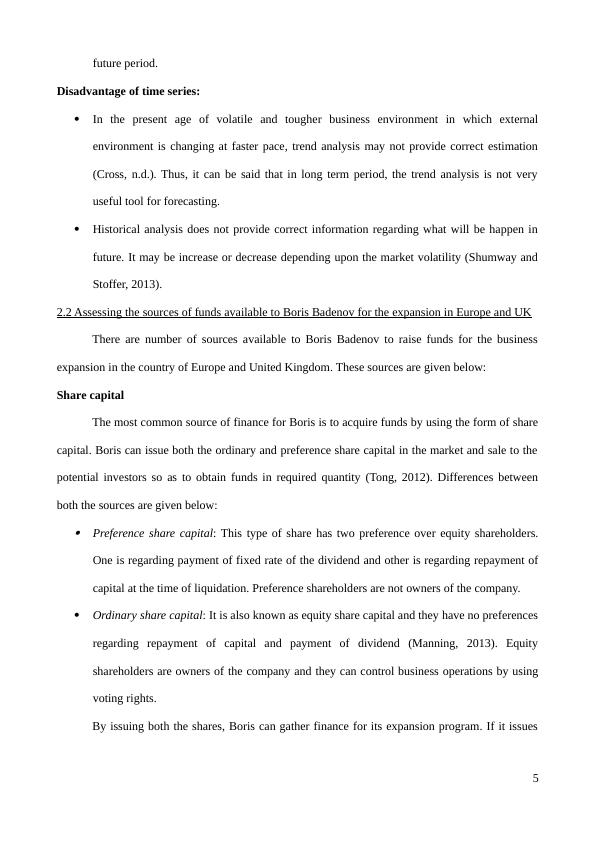
preference share capital than it is necessary for the company to pay fixed and timely dividend to theshareholders while, it is not necessary in case of equity shares. On contrary, investors will investmoney with an objective of getting high return in terms of dividend and capital appreciation (Cole,Kanz and Klapper, 2015). Henceforth, they examine risk and return associated with their funds andtake appropriate decisions. While, its disadvantage is that it dilutes controlling rights to the equityshareholder which they can use to control daily operations. Bank LoanAnother source to gain extra money is borrowing through financial institutions such as bank.They provide funds for different durations according to the requirement. Boris Badenov can takelong term borrowings from bank to meet its capital requirement of expansion. Bank provides loanfor a fixed time period at an interest rate. Benefit of obtaining funds from bank loan is that it can berepaid in instalments. Moreover, it does not diversify business control to the lenders. While, itsdrawback is that it imposes fixed financial burden in the form of interest. Moreover, Boris has tocomply with legal formalities to acquire funds (Ge, Kim and Song, 2012). For instance, lendergrants loan after demanding collateral security or guarantee so that lending can be secured.Furthermore, they evaluate risk involved in it and provide loan in case if Boris is able to bear debtinterest and pay it timely. Retained earnings:Balance of profit remaining after the distribution of dividend is known as retained earnings.Boris Badenov can use its retained earnings for the business expansion in Europe and UK. Benefitof this is that it does not impose any financial cost to the company while its drawback is thatexcessive ploughing back of profits can create adverse impact on the investors (Badri andMohamad, 2014). Venture capital:Another way to raise funds is venture capital. In fastest growing business, investors are6
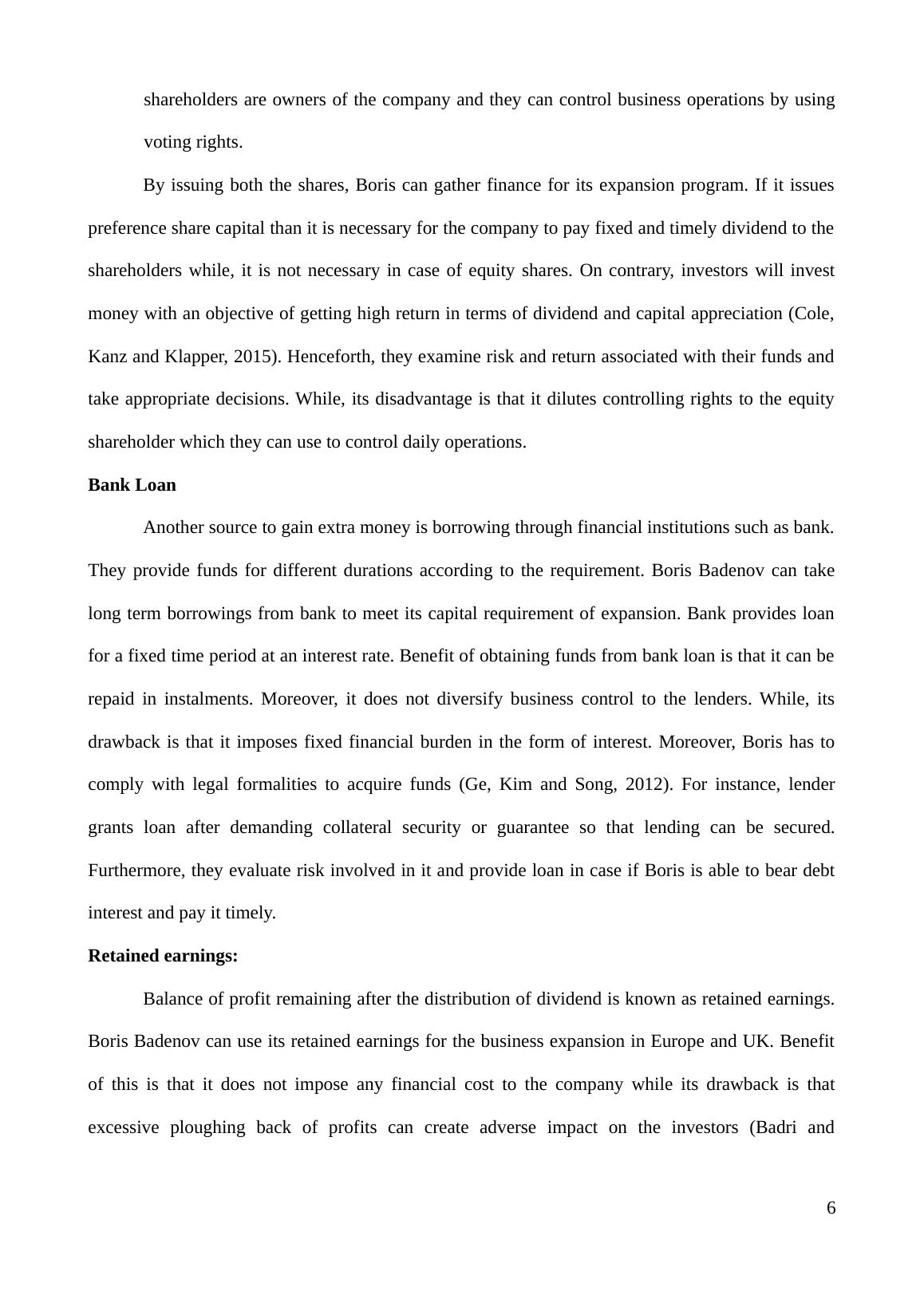
interested to invest their money so as to get high return (Cox, 2014). Thus, Boris can use this sourceand obtain funds from venture capitalists such as merchant banks and investment specialists. Debentures:It is an acknowledgement and promise given to the holder regarding payment of fixedamount of interest during fixed interval of time and repayment of principle on the maturity. Boriscan issue debentures to get long term debts to finance its expansion project. Benefit of this is that itis not secured by assets or collateral security. Buyers purchase it by believing on issuer’s reputation.Lease:Boris can acquire fixed assets through using lease financing. With the help of this, companycan acquire land, building and machinery at some rental charges for a fixed duration. Its benefit isthat Boris does not need to purchase the assets and drawback of this is that rental charges involvessome interest as finance cost. TASK 33.1 Selecting appropriate budgeting targetBudgeting is an advance or future planning of business operations. It takes into account theexpenditures and revenues for the future period. In the present age of changing and highlyfluctuating business environment, it is essential for Boris Badenov to maintain an appropriatebudgetary target to carry out its functions smoothly and effectively. This in turn, company cansurvive for a longer period (Cox, 2014). In such respect, special focus should be given to deciderealistic expenditures and revenue targets so that Boris will be able to get competitive advantageover the competitors. With reference to Boris, historical analysis of actual and budgeted targets willhelp to determine more realistic figures related to set standards for future years.RevenueBoris Badenov's actual revenue was increased by 7.69% from 4900 to 5300 in 2014.However, its targets revenue was increased by 21.15% from 5200 to 6300. It indicates that Boris set7

very high targets as compared to the actual turnover trend. On contrary to it, in 2014, budgetaryturnover was increased by 28.57% from actual result of 2013. Thus, according to it, Boris expectsthat revenue will increase by approximately 28.57% p.a.. Material:Actual material cost in 2014 was increased by 20.2%. Hence, in order to improve sales,Boris also enhanced its target material cost to 1300 by 31.31% which was comparatively higherthan the increase in revenue that was of 28.57% and it was not good for the company. Labour Actual labour cost was remained constant in both the years while target cost was increasedby 3.45% from historical actual labour cost of 870. Thus, it was correct estimation because of thepossibility of recruiting more workers and little increase in their wages rate.Depreciation: It is a fixed cost which remained constant to 200. Thus, it can be said that in future, it willremain constant to this current level. Maintains cost:Actually, it was decreased by 68.97% to 45 in 2014. Due to this, Boris Badenov declined itstarget for maintains cost in 2014 to 25. It assumed 80% decline from previous year's actualmaintains cost of 145. Moreover, in both the years, variances are 16% and 80% respectively. Itindicates that standard cost of maintains cost is very low. Inspection charges:In 2014, Boris forecasted 100% increase in the inspection charges and increase it from 10 to20. Similarly, actual cost was improved by 100% which indicates that target cost achieved. Fuel and power cost:Actually, it was increased by 11.54% in 2014 and therefore, Boris expected that fuel andpower cost would also be increased by 15.38%. However, in 2014, variance was arisen by 3.33%. 8

End of preview
Want to access all the pages? Upload your documents or become a member.
Related Documents
Manage Budgets and Financial Plan - Deskliblg...
|20
|3312
|126
Finance and Funding in the Travel and Tourism Sector Assignment - Carnival plclg...
|20
|4595
|324
FINANCE IN THE HOSPITALITY INDUSTRY TABLE OF CONTENTS INTROUCTION 1 TASK 11 1.1 Sources of finance in the hobbyitality industrylg...
|23
|6180
|453
Management Accounting – PDFlg...
|5
|858
|16
Capital Investment Appraisal, CVP Analysis, Equity vs Bank Loan for Long-term Finance Requirementslg...
|20
|4051
|454
